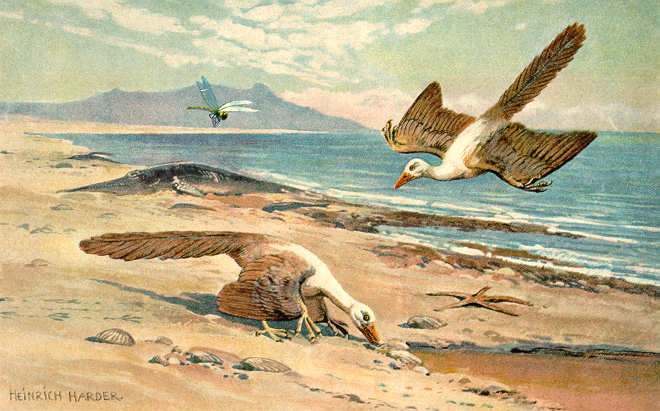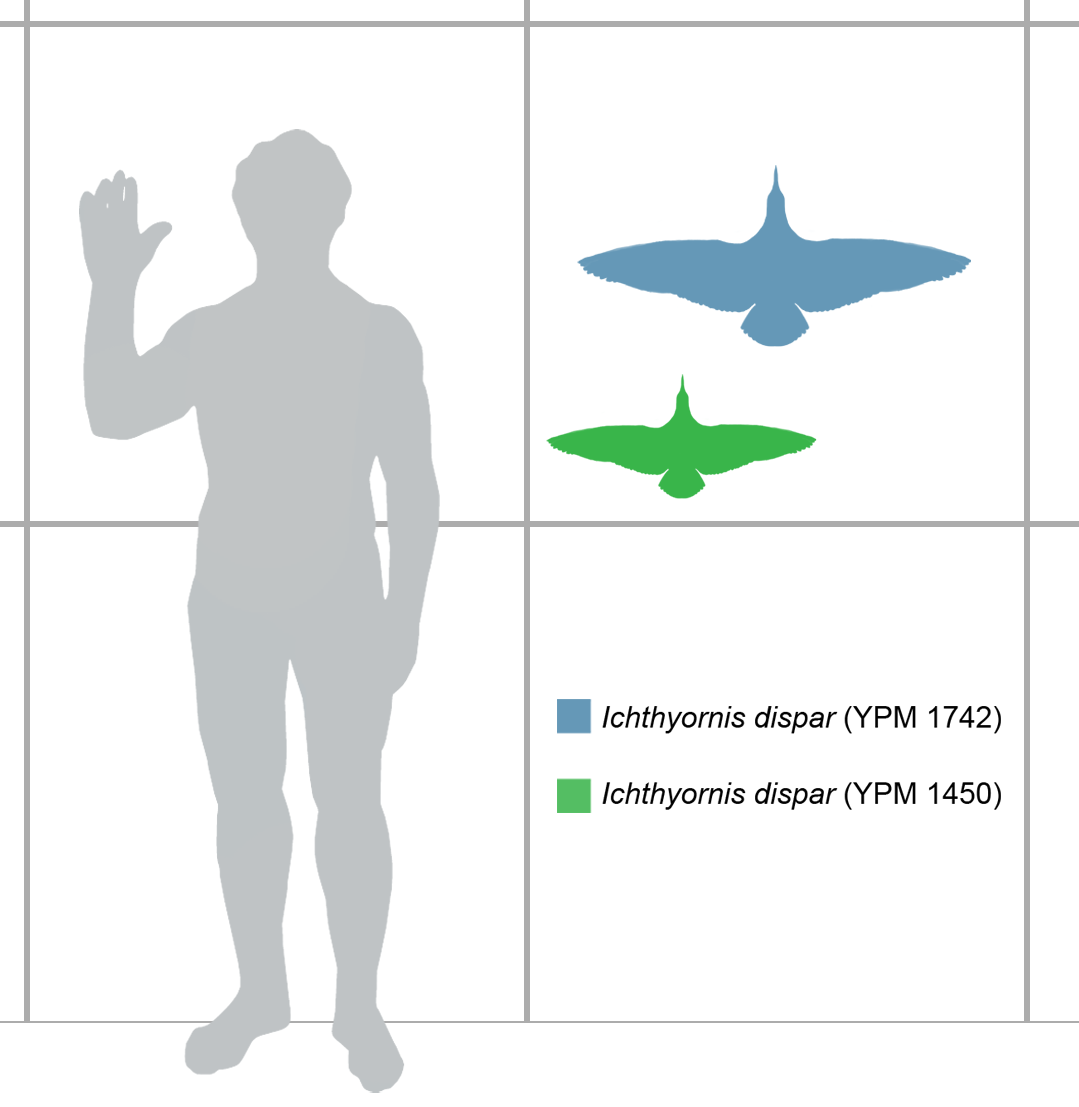|
Odontognathae
230px, Ichthyornis skeletons Odontognathae is a disused name for a paraphyletic group of toothed prehistoric birds. The group was originally proposed by Alexander Wetmore, who attempted to link fossil birds with the presence of teeth, specifically of the orders Hesperornithiformes and Ichthyornithiformes. As such they would be regarded as transitional fossils between the reptile-like " Archaeornithes" like ''Archaeopteryx'' and modern birds. They were described by Romer as birds with essentially modern anatomy, but retaining teeth. Romer, A. S. & Parsons, T. S. (1985): ''The Vertebrate Body.'' (6th ed.) Saunders, Philadelphia. Traits Unlike the dinosaur-like " Archaeornithes", the various types of birds assigned to the Odontognathae had short tails with a plowshare-shaped pygostyle and a well developed carina for flight muscle. They also shared the feature of intramandibular articulation, something that is actually absent in ''Archaeopteryx'', but found in many of its theropo ... [...More Info...] [...Related Items...] OR: [Wikipedia] [Google] [Baidu] |
Archaeornithes
The Archaeornithes, classically Archæornithes, is an extinct group of the first primitive, reptile-like birds. It is an evolutionary grade of transitional fossils, the primitive birds halfway between non avian dinosaur ancestors and the derived modern birds (avian dinosaur). Fossils of early birds were poorly known until the late 20th century. Of those known, all fell into either the relatively modernly built birds with fused ribcage and the breastbone extended into a keel, or the " Urvogels" of the Solnhofen Plattenkalk of late Jurassic age. As the physiological and anatomical difference between the two was so great, the subclass Archaeornithes was erected for the latter. With the unearthing of several well preserved early bird fossils in the last decades of the 20th century and early 21st century, our knowledge of the evolution of birds has increased dramatically. The evolution of the modern avian traits such as the compact body, clawless wing and the alula are now known to ap ... [...More Info...] [...Related Items...] OR: [Wikipedia] [Google] [Baidu] |
Ichthyornis Yale
''Ichthyornis'' (meaning "fish bird", after its fish-like vertebrae) is an extinct genus of toothy seabird-like ornithuran from the late Cretaceous period of North America. Its fossil remains are known from the chalks of Alberta, Alabama, Kansas (Greenhorn Limestone), New Mexico, Saskatchewan, and Texas, in strata that were laid down in the Western Interior Seaway during the Turonian through Campanian ages, about 95–83.5 million years ago. ''Ichthyornis'' is a common component of the Niobrara Formation fauna, and numerous specimens have been found. ''Ichthyornis'' has been historically important in shedding light on bird evolution. It was the first known prehistoric bird relative preserved with teeth, and Charles Darwin noted its significance during the early years of the theory of evolution. ''Ichthyornis'' remains important today as it is one of the few Mesozoic era ornithurans known from more than a few specimens ... [...More Info...] [...Related Items...] OR: [Wikipedia] [Google] [Baidu] |
Archaeopteryx
''Archaeopteryx'' (; ), sometimes referred to by its German name, "" ( ''Primeval Bird''), is a genus of bird-like dinosaurs. The name derives from the ancient Greek (''archaīos''), meaning "ancient", and (''ptéryx''), meaning "feather" or "wing". Between the late 19th century and the early 21st century, ''Archaeopteryx'' was generally accepted by palaeontologists and popular reference books as the oldest known bird (member of the group Avialae). Older potential avialans have since been identified, including '' Anchiornis'', '' Xiaotingia'', and '' Aurornis''. ''Archaeopteryx'' lived in the Late Jurassic around 150 million years ago, in what is now southern Germany, during a time when Europe was an archipelago of islands in a shallow warm tropical sea, much closer to the equator than it is now. Similar in size to a Eurasian magpie, with the largest individuals possibly attaining the size of a raven, the largest species of ''Archaeopteryx'' could grow to about in ... [...More Info...] [...Related Items...] OR: [Wikipedia] [Google] [Baidu] |
Ornithurae
Ornithurae (meaning "bird tails" in Greek) is a natural group which includes the common ancestor of '' Ichthyornis'', '' Hesperornis'', and all modern birds as well as all other descendants of that common ancestor. Classification Ernst Haeckel coined the name in 1866 and included in the group all "true birds" with the "characteristic tail morphology of all extant birds" (translation by Jacques Gauthier). This distinguishes the group from ''Archaeopteryx'', which Haeckel placed in another new group called Sauriurae. Said simply, modern birds have short, fused pygostyle tails, while ''Archaeopteryx'' retained the long tail characteristic of non-avian theropod dinosaurs.Haeckel, Ernst (1866). ''Generelle Morphologie der Organismen''. Berlin: Georg Reimer. Gauthier converted Ornithurae into a clade, giving it a branch-based definition: "extant birds and all other taxa, such as ''Ichthyornis'' and Hesperornithes, that are closer to extant birds than is ''Archaeopteryx''". Later he ... [...More Info...] [...Related Items...] OR: [Wikipedia] [Google] [Baidu] |
Crown Group
In phylogenetics, the crown group or crown assemblage is a collection of species composed of the living representatives of the collection, the most recent common ancestor of the collection, and all descendants of the most recent common ancestor. It is thus a way of defining a clade, a group consisting of a species and all its extant or extinct descendants. For example, Neornithes (birds) can be defined as a crown group, which includes the most recent common ancestor of all modern birds, and all of its extant or extinct descendants. The concept was developed by Willi Hennig, the formulator of phylogenetic systematics, as a way of classifying living organisms relative to their extinct relatives in his "Die Stammesgeschichte der Insekten", and the "crown" and "stem" group terminology was coined by R. P. S. Jefferies in 1979. Though formulated in the 1970s, the term was not commonly used until its reintroduction in 2000 by Graham Budd and Sören Jensen. Contents of the crown ... [...More Info...] [...Related Items...] OR: [Wikipedia] [Google] [Baidu] |
The Auk ''Ornithology'', formerly ''The Auk'' and ''The Auk: Ornithological Advances'', is a peer-reviewed scientific journal and the official publication of the American Ornithological Society (AOS). It was established in 1884 and is published quarterly. The journal covers the anatomy, behavior, and distribution of birds. It was named for the great auk, the symbol of the AOS. In 2018, the Am |


.jpg)